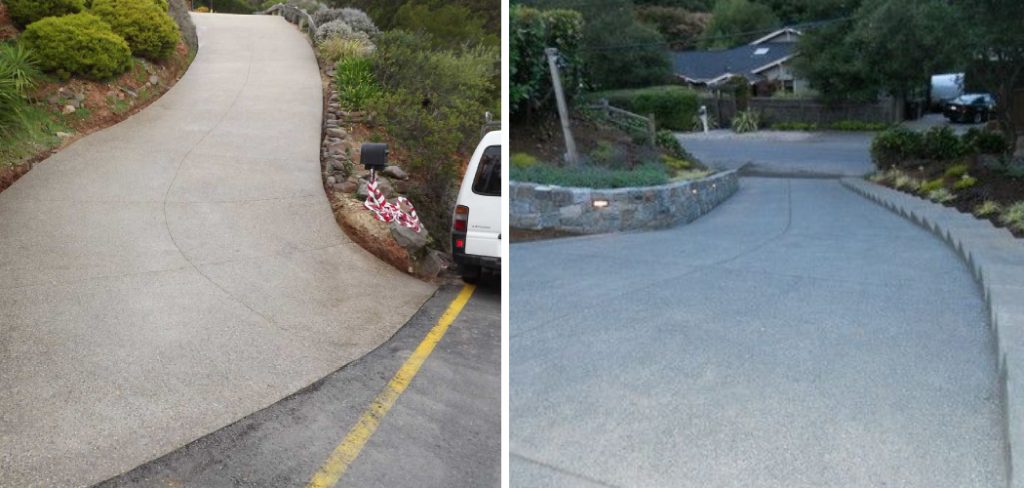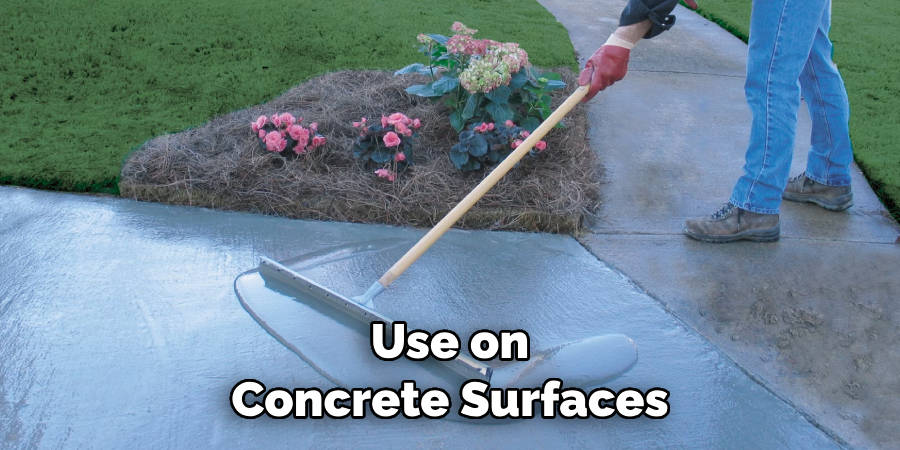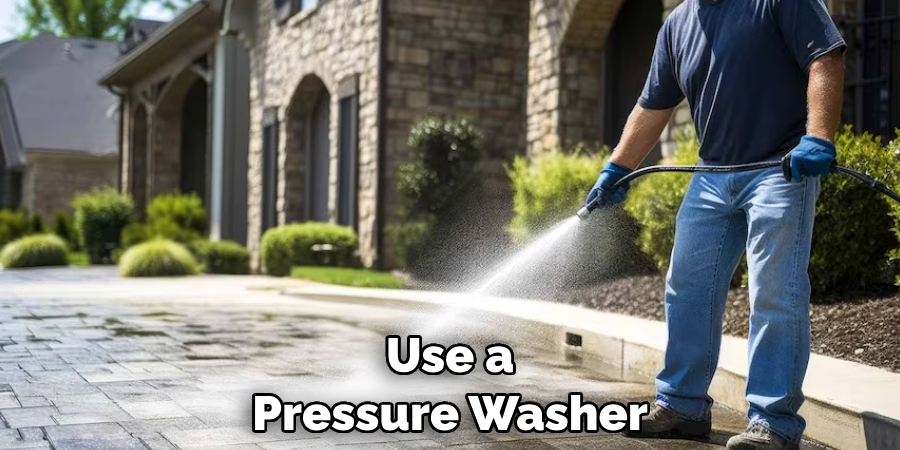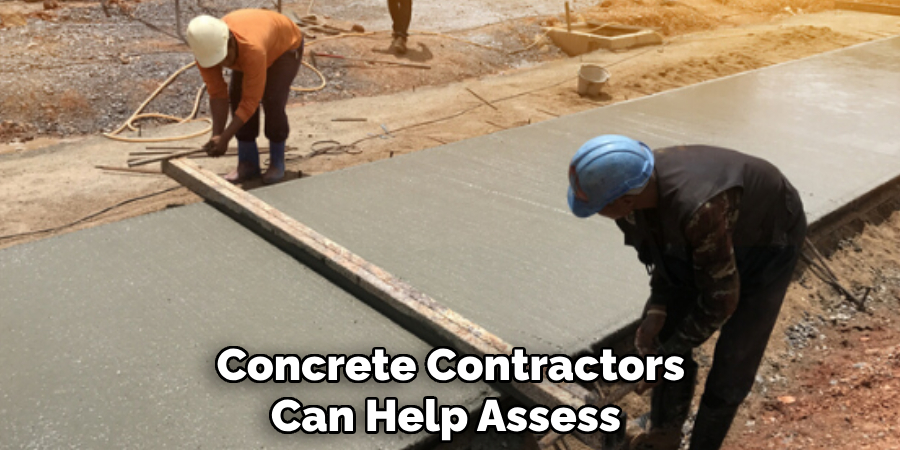There are many reasons why you should learn how to fix a slippery concrete driveway. For one, it can be a safety hazard for both yourself and others who may use your driveway. Slippery driveways are especially dangerous during the colder months when ice and snow can accumulate on its surface.

The main advantage of fixing a slippery concrete driveway is to improve safety. Slippery driveways can be dangerous, especially during rainy or snowy weather conditions. They can increase the risk of accidents for both pedestrians and vehicles. You can find step-by-step instructions on how to fix slippery concrete driveway in this blog article.
Step-by-step Instructions for How to Fix Slippery Concrete Driveway
Step 1: Inspect the Surface
Before starting to fix a slippery concrete driveway, it’s important to inspect the surface and determine the cause of the slipperiness. Is it due to algae or mildew growth? Or is there an issue with the texture of the concrete itself? This will help you determine the best course of action for fixing the problem.
Step 2: Clean off Debris
If there is debris on your concrete driveway, make sure to clean it off thoroughly before attempting any fixes. Leaves, dirt, and other debris can make surfaces more slippery and can also affect how well any treatment adheres to the concrete.
A pressure washer can be an effective tool for cleaning off your driveway and removing built-up grime and debris. Be sure to set the pressure at a safe level for your concrete surface, as too much pressure can cause damage.
Step 3: Try a Cleaning Solution
If a pressure washer alone isn’t enough to remove the slipperiness from your driveway, consider using a specialized cleaning solution designed for concrete surfaces. Be sure to follow the instructions carefully and test it on a small area before applying it to the entire surface.
An anti-slip coating can be an effective way to provide traction on your concrete driveway. These coatings come in different forms such as paint or sealant and can often be applied with a roller or brush. Be sure to choose a product specifically designed for use on concrete surfaces.

Step 4: Add Fine Aggregate
Another option for improving the traction on your slippery driveway is to add a fine aggregate, such as sand or crushed walnut shells, to the surface. This can be mixed into a sealant or paint before applying it to the driveway.
In some cases, the slipperiness of a concrete driveway may be due to its smooth surface. In these instances, using an acid etching treatment can help create a slightly rougher texture that provides more grip. Be sure to follow all safety precautions and use proper protective equipment when handling acid.
Step 5: Consider Sealing Your Driveway
Sealing your concrete driveway can provide protection against moisture and other elements, and can also help improve its traction. There are various sealants available for different types of concrete surfaces, so be sure to choose one that is suitable for your driveway.
There are several DIY solutions you can try to make your slippery concrete driveway safer. These include using cat litter or baking soda on the surface to create more traction, or mixing dish soap with hot water and scrubbing the surface with a stiff brush.
Step 6: Seek Professional Help
If none of these steps seem to be working or if you’re not comfortable attempting them yourself, it may be time to seek professional help. A contractor who specializes in concrete driveways will have the necessary knowledge and equipment to properly fix any slipperiness issues and ensure your driveway is safe to use.
By following these step-by-step instructions, you should be able to fix a slippery concrete driveway and prevent any potential accidents. It’s important to regularly maintain your driveway and address any issues promptly to keep it in good condition for years to come.
Safety Tips for How to Fix Slippery Concrete Driveway
- Keep the driveway clean and free from debris, as this can cause slippery surfaces.
- Use a pressure washer or a high-power hose to remove any built-up dirt, grime, or oil on the concrete surface.
- Avoid using harsh chemical cleaners as they may not only damage the concrete but also make it more slippery.
- Fill in any cracks or holes in the concrete with a filler material. This will not only improve traction but also prevent further deterioration of the surface.
- Apply an anti-slip coating specifically designed for concrete driveways. These coatings are usually available in hardware stores and can effectively reduce slipperiness.
- Consider installing grooves or patterns on the surface of your driveway to provide better grip for vehicles and foot traffic.
- If you live in an area with frequent rain or snow, apply a sealant to your concrete driveway to prevent water from seeping into the pores and making it slippery.

By following these safety tips and precautions, you can effectively fix a slippery concrete driveway and make it safe for yourself and others. Remember to always prioritize safety when dealing with any potential hazards around your property.
What Are the Main Causes of a Slippery Concrete Driveway?
A concrete driveway is one of the most common types of driveways found in homes and businesses. However, despite its durability and low maintenance, it can become quite slippery when wet or covered with ice or snow. This poses a safety hazard for anyone walking or driving on it.
1. Poor Drainage
One of the main reasons why a concrete driveway becomes slippery is due to poor drainage. When water cannot properly drain off the surface, it accumulates and creates a layer of water on top. This makes the surface extremely slippery and dangerous to walk or drive on.
2. Dirt and Debris Buildup
Another factor that contributes to a slippery concrete driveway is dirt and debris buildup. As these substances accumulate on the surface, they create a layer that reduces traction and makes it slippery.
3. Algae and Moss Growth
In areas with high humidity or frequent rainfall, algae and moss can grow on the surface of a concrete driveway. These organisms thrive in wet conditions and can make the surface extremely slippery.
4. Lack of Texture
Some concrete driveways are poured with a smooth finish, which may look aesthetically pleasing but lacks texture. Without proper texture, the surface can become dangerously slick when wet. Now that you know the main causes of a slippery concrete driveway, let’s discuss how to fix it.
How Can Regular Maintenance of a Concrete Driveway Prevent It From Becoming Slippery?
A concrete driveway is a practical and durable choice for many homeowners. However, it can become hazardous when it gets slippery. Whether the cause is due to algae growth, oil spills, or simply wet weather, a slippery concrete driveway can be dangerous for both vehicles and pedestrians. Fortunately, there are several ways to fix this issue and prevent accidents from happening. In this guide, we will discuss some effective methods on how to fix a slippery concrete driveway.
1. Cleaning and Regular Maintenance
One of the simplest ways to fix a slippery concrete driveway is by cleaning it regularly. Sweeping away debris such as leaves, dirt, or gravel can help improve traction on your driveway. You can also use a pressure washer to remove any stubborn stains or buildup.

Regular maintenance is also crucial in preventing your concrete driveway from becoming slippery. Sealing the concrete can protect it from water penetration and chemical spills, which can make it more slippery. Additionally, keeping your driveway free of oil or other automotive fluids can prevent them from pooling and creating a slick surface.
2. Chemical Treatments
If cleaning and regular maintenance do not fully resolve the slipperiness on your concrete driveway, you may consider using chemical treatments. These products are designed specifically to improve traction on surfaces such as concrete and can be easily applied by following the instructions on the packaging.
There are various types of chemical treatments available in the market, including epoxy coatings, non-slip sealers, and anti-skid additives. These products work by creating a textured surface on the concrete, which provides better grip and prevents slipping.
3. DIY Solutions
For those who prefer a more hands-on approach, there are several DIY solutions that can help fix a slippery concrete driveway. One popular method is to mix sand into your concrete sealer before applying it. This will create a rougher surface, making it less slippery.
Another option is to use cat litter or sawdust on areas where you frequently walk or park your vehicles. These materials have absorbent properties that can provide better traction and prevent slips and falls.
However, please note that these DIY solutions may not be as effective as professional methods and may require more frequent reapplication.
4. Professional Services
If all else fails, it may be best to seek professional services for a more permanent solution. Concrete contractors can help assess the cause of the slipperiness and provide recommendations on how to fix it.

Some common professional methods include acid washing, shot blasting, or applying an epoxy coating with non-slip additives. These processes require specialized equipment and expertise and can provide long-lasting results.
Conclusion
In conclusion, fixing a slippery concrete driveway is a necessary task in order to ensure safety and prevent accidents. While there are a few different methods for addressing this issue, it is important to carefully consider which solution will be most effective and long-lasting for your specific situation. Additionally, it is crucial to regularly maintain your driveway to prevent the problem from recurring.
One of the main disadvantages of fixing a slippery concrete driveway is that it can be time-consuming and physically demanding. Depending on the severity of the slipperiness, you may need to put in significant effort and resources into repairing or resurfacing your driveway.
However, not taking action could result in more serious consequences such as injuries or vehicle damage. I hope this article has been beneficial for learning how to fix slippery concrete driveway. Make Sure the precautionary measures are followed chronologically.
